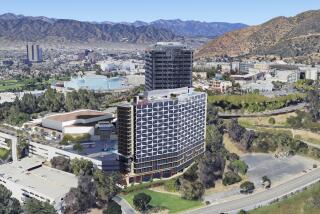GRAND AVENUE PROJECT PASSES GO
- Share via
Despite criticism about tax breaks and land giveaways, the Los Angeles County Board of Supervisors and the Los Angeles City Council gave final approvals Tuesday to a sprawling mini-city atop Bunker Hill that will alter L.A.’s skyline and set a course for future development in downtown.
Elected officials and other backers of the Grand Avenue project described the vote as a turning point for Los Angeles, whose civic leaders have tried for decades without success to establish a central cultural hub downtown that would draw people from throughout the region.
“This is a historic day for Los Angeles. It changes the entire complexion of the center of our city,” said civic booster Eli Broad, who is spearheading the development.
The $2.05-billion Grand Avenue project would be the largest single development in downtown history, and would be built almost entirely on public land that would be leased for 99 years to mega-developer the Related Cos. It has few if any equals in the region, in part because of the complexity and scope of the private-public partnership.
The project also has emerged as Los Angeles’ most ambitious effort to create dense, high-rise residential developments next to rail lines, offices, cultural attractions and shopping.
Though some consider the project a model for “smart growth” aimed at encouraging people to walk and use mass transit rather than drive, others see it as a tax giveaway that is not in the interests of local government. Critics complain that Related is essentially getting a double subsidy: The city and county are leasing the developer public land for a profit-making business at the same time that the city is granting breaks on future hotel and parking taxes.
They also question whether the project would be the regional magnet its backers hope.
Both the council and board voted Tuesday, in part to demonstrate their lock-step support for the project. The City Council approved the deal 13 to 0, with Councilman Ed Reyes absent. The supervisors approved the project 4 to 1, with Mike Antonovich voting against it.
By approving the deal, the governmental bodies agreed to transfer the land for the first phase of the project -- a county-owned parcel -- to the Grand Avenue Authority, a joint city-county agency that will in turn lease it to Related. (Later phases include land owned by the city’s redevelopment agency.)
The votes green-light all three phases of Grand Avenue, which calls for at least five new high-rise buildings and 3.6 million square feet of development.
The first phase would include two translucent glass residential towers to be designed by Frank Gehry, one 49 stories and the other 24.
One tower would include a five-star Mandarin Oriental hotel. Two hundred of the 1,000 housing units included in the first phase would be reserved for low-income residents.
The municipal bodies also approved the development of a 16-acre park between the Music Center and City Hall as part of the project’s first phase -- one of the civic benefits that backers said was vital to the project’s success.
The development marks the furthest-reaching effort by local leaders to turn downtown into a 24-hour district on par with areas of New York, Chicago, London and Paris. Downtown has long retained a reputation as a sleepy district that virtually shuts down at sunset, though a recent boom in lofts and other high-end residential development is slowly changing that.
The project will rise in an area that since the early 1960s has been at the center of plans for downtown’s revival. Through the 1950s, Bunker Hill was a funky -- even seedy -- collection of Victorian apartment buildings and boardinghouses that inspired some Los Angeles writers. The city leveled the neighborhood to make way for an extension of the high-rise district.
Backers believe that Grand Avenue can succeed where other downtown revitalizations have failed. They said that it would rise amid such cultural landmarks as Walt Disney Concert Hall, the other venues of the Music Center and the Museum of Contemporary Art at a time when downtown is suddenly a hot destination for the first time in decades.
But even some supporters said it remained to be seen whether such a massive undertaking could change the way people think about the city center.
“Done right, redevelopment is a tool for good. Done wrong, it’s horrible,” county Supervisor Zev Yaroslavsky said. “I really believe, let me tell you, there have been more pairs of eyes looking over this project than any I can ever remember.”
Though the project has attracted mostly praise at recent public meetings, the tax breaks and other public support have their detractors.
“The desire for an iconic skyline, that’s just for aesthetics,” said Antonovich, a longtime opponent of the project. “That should be borne by a developer and not the taxpayers who reside in the entire county.”
Christopher Sutton, an attorney for the Westin Bonaventure Hotel, which has opposed the tax breaks for the Mandarin Oriental, told the City Council and the Board of Supervisors that his client was prepared to take legal action to block the project if necessary. He called the project a “direct threat” to the Bonaventure.
The hotel issued a similar ultimatum when the convention center at L.A. Live, another mega-project being built at the south end of downtown, received a larger tax rebate in 2005. But that project has moved forward and will open its first phase this year.
Related Cos. said the Grand Avenue project was not feasible without the subsidies. The developer has spent months negotiating behind the scenes for the tax breaks, an increasingly common incentive used by cities to attract catalytic projects.
Early estimates put the tax rebates for Grand Avenue at $40 million over 20 years. But a recent report from the city’s legislative analyst estimated that the rebates could cost $66 million. The largest tax break would be in the 14% city hotel tax, a maximum of $60.5 million over 20 years, the report said.
From the beginning, the Grand Avenue project has been marked by a nontraditional public-private marriage. Besides the proposed tax breaks, government agencies are providing the land, investing in street improvements and subsidizing affordable housing in the project.
Related and its fiscal partners, meanwhile, are taking much of the financial risk -- particularly tenuous in a downtown real estate market that has shown signs of softening. They also are subject to a number of requirements, including the condition that all construction and permanent jobs in the development meet the city’s “prevailing” or “living” wage requirements.
In addition, the agreement calls for developers to give at least 30% of jobs to workers living within five miles of the site. That clause was criticized by Antonovich, who described the city deal as unfair to workers who live elsewhere in the county.
“It’s Jim Crow of the 21st century,” Antonovich said. “We’re denying them their constitutional rights to work in their own county?”
Despite those criticisms, several civic leaders said it was rare for the city and county to cooperate so fully as they have to move the Grand Avenue project forward.
Councilwoman Jan Perry, who serves on the joint powers authority board, called the level of cooperation unprecedented.
Though the city, county and developer each would bear a portion of the project’s financial risk, each also would profit if the development was a success.
The city and county could reap substantial tax revenue from the project, far more than they receive now from the properties, which are either vacant or parking lots.
Related has written a $50-million check to the civic agencies, which represents the prepaid ground lease on the first phase and a portion of the second phase of the project.
Related has said that construction of the first phase is expected to start in October and be completed in June 2011.
jack.leonard@latimes.com
More to Read
Sign up for Essential California
The most important California stories and recommendations in your inbox every morning.
You may occasionally receive promotional content from the Los Angeles Times.














